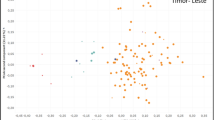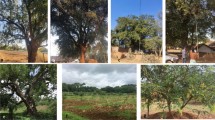Abstract
In this study, 28 simple sequence repeat (SSR) primer sets were used to analyze the genetic diversity, population structure, and genetic relationships among 37 accessions of foxtail millet from Korea, China and Pakistan. A total of 298 alleles were detected with an average allele number of 10.6 per locus among 37 foxtail millet accessions. The number of alleles per locus ranged from 2 (b226) to 20 (b236). Of the 298 alleles, 138 alleles (46.3%) were rare (frequency < 0.05), 152 alleles (51.0%) were detected at an intermediate frequency (range, 0.05–0.50), and eight alleles (2.7%) were abundant (frequency > 0.50), respectively. The average gene diversity values were 0.652, 0.692, and 0.491 and polymorphic information content values were 0.621, 0.653, and 0.438, for accessions from Korea, China, and Pakistan, respectively. The accessions from China showed higher SSR diversity than those from Korea and Pakistan. A phylogenetic tree constructed using the un-weighted pair group methods with arithmetic mean algorithm revealed three major groups of accessions that were not congruent with geographical distribution patterns with a few exceptions. The lack of correlation between the accession clusters and their geographic location indicates that the diffusion of foxtail millet from China to Korea might have occurred through multiple routes. Our results provide support for the origin and diffusion route of foxtail millet in East Asia. This SSR-based assessment of genetic diversity, genetic relationships, and population structure among genetic resources of foxtail millet landraces will be valuable to foxtail millet breeding and genetic conservation programs in Korea.
Similar content being viewed by others
References
Akagi H, Yokozaki Y, Inagaki A and Fujimura T (1997) Highly polymorphic SSRs of rice consist of AT repeats, and a classification of closely related cultivars with these SSR loci. Theor. Appl. Genet. 94: 61–67.
Dellaporta SL, Wood J and Hicks JB (1983) A plant DNA mini-preparation: Version II. Plant Mol. Biol. Rept. 1: 19–21.
Dice LR (1945) Measures of the amount of ecologic association between species. Ecology 26: 297–302.
Enoki H, Sato H and Koinuma K (2002) SSR analysis of genetic diversity among maize inbred lines adapted to cold regions of Japan. Theor. Appl. Genet. 104: 1270–1277.
Evanno G, Regnaut S and Goudet J (2005) Detecting the number of clusters of individuals using the software STRUCTURE: a simulation study. Mol. Ecol. 14: 2611–2620.
Fogg WH (1983) Swidden cultivation of foxtail millet by Taiwan Aborigens: a cultural analogue of the domestication of Setaria italica in China. In: UoC press (cd). The origin of Chinese civilization. Berkeley, CA, USA, pp 97–115.
Fukunaga K, Domon E and Kawase M (1997) Ribosomal DNA variation in foxtail millet, Setaria italica (L.) P. Beauv., and a survey of variation from Europe and Asia. Theor. Appl. Genet. 95: 751–756.
Fukunaga K, Wang Z, Kato K and Kawase M (2002) Geographical variation of nuclear genome RFLPs and genetic differentiation in foxtail millet, Setaria italica (L.) P. Beauv. Genet. Resour. Crop Evo. 49: 95–101.
Fukunaga K, Ichitani K and Kawase M (2011) rDNA polymorphism of foxtail millet (Setaria italica ssp. italica) landraces in northern Parkistan and Afghanistan and in its wild ancestor (S. italica ssp. viridis). Genet. Resour. Crop Evo. 58: 825–830.
Gupta S, Kumari K, Sahu PP, Vidapu S and Prasad M (2011) Sequence-based novel genomic SSR markers for robust genotyping purposes in foxtail millet [Setaria italica (L.) P. Beauv.]. Plant Cell Rep. 31: 323–337.
Jia X, Shi Y, Song Y, Wang G, Wang T and Li Y (2007) Development of EST-SSR in foxtail millet (Setaria italica). Genet. Resour. Crop Evo. 54: 233–236.
Jia X, Zhang Z, Liu Y, Zhang C, Shi Y, Song Y, Wang T and Li Y (2009) Development and genetic mapping of SSR markers in foxtail millet (Setaria italica (L.) P. Beauv.). Theor. Appl. Genet. 118: 821–829.
Jusuf M and Pernes J (1985) Genetic variability of foxtail millet (Setaria italica P Beauv). Theor. Appl. Genet. 71: 385–391.
Kawase M and Sakamoto S (1984) Variation, geographical distribution and genetic analysis of esterase isozymes in foxtail millet, Setaria italica (L.) P. Beauv. Theor. Appl. Genet. 67: 529–533.
Kawase M, Fukunaga K and Kato K (2005) Diverse origins of waxy foxtail millet crops in East and Southeast Asia mediated by multiple transposable element insertions. Mol. Gen. Genomics 2005. 274: 131–140.
Kihara H and Kishimoto E (1942) Bastarde zwischen Setaria italica und S. viridis (in Japanese with German summary). Bot. Mag. 20: 63–67.
Kim SK, Sohn EY and Lee IJ (2009) Starch properties of native foxtail millet, Setaria italica Beauv. J. Crop Sci. Biotech. 12(1): 59–62.
Kim EJ, Sa KJ, Yu CY and Lee JK (2010) Morphological Variation of Foxtail Millet (Setaria italica (L.) P. Beauv.) Germplasm Collected in Korea, China and Pakistan. Korean J. Breed. Sci. 42: 181–187.
Kim EJ, Sa KJ and Lee JK (2011) Genetic variation of foxtail millet [Setaria italica (L.) P. Beauv.] among accessions collected from Korea revealed by AFLP markers. Korean J. Crop Sci. 56: 322–328.
Lee JK and O. Ohnishi (2003) Genetic relationships among cultivated types of Perilla frutescens and their Weedy Types in East Asia revealed by AFLP markers. Genet. Resour. Crop Evo. 50: 65–74.
Lee JK and Kim NS (2007) Genetic diversity and relationships of cultivated and weedy types of Perilla frutescens collected from East Asia revealed by SSR markers. Korean J. Breed. Sci. 39(4): 491–499.
Le Thierry d’Ennequin M, Panaud O, Toupance B and Sarr A (2000) Assessment of genetic relationships between Setaria italica and its wild relative S. viridis using AFLP markers. Theor. Appl. Genet. 100: 1061–1066.
Li Y and Wu S (1996) Traditional maintenance and multiplication of foxtail millet (Setaria italica (L.) P. Beauv.) landraces in China. Euphytica 87: 33–38.
Li H, Li C and Pao W (1945) Cytological and genetic studies of the interspecific cross of the cultivated foxtail millet, Setaria italica P. Beauv., and the green foxtail millet, S. viridis L. J. Amer. Soc. Agron. 9: 32–54.
Li Y, Wu SZ and Cao YS (1995) Cluster analysis of an international collection of foxtail millet (Setaria italica (L.) P. Beauv.). Euphytica 83: 79–85.
Liu K and Muse SV (2005) PowerMarker: an integrated analysis environment for genetic marker analysis. Bioinformatics 21: 2128–2129.
Murai M and Ohnishi O (1996) Population genetics of cultivated common buckwheat, Fagopyrum esculentum Moench. X. diffusion routes revealed by RAPD markers. Genes Genet. Syst. 71: 211–218.
Park YJ, Lee JK and Kim NS (2009) Simple Sequence Repeat Polymorphisms (SSRPs) for Evaluation of Molecular Diversity and Germplasm Classification of Minor Crops. Molecules 14: 4546–4569; doi: 10.3390/molecules14114546.
Pritchard JK and Wen W (2004) Documentation for STRUCTURE software: The University of Chicago Press, Chicago.
Pritchard JK, Stephens M and Donnelly P (2000) Inference of population structure using multilocus genotype data. Genetics 155: 945–959.
Rafalski JA, Vogel JM, Morgante M, Powell W, Andre C and Tingey SV (1996) Generating and using DNA markers in plants. In: Birren B, Lai E(eds), Non-mammalian genetic analysis. A practical guide. Academic Press, San Diego, 75–134.
Rohlf FJ (2000) NTSYS-pc: Numerical taxonomy and multivariate analysis system. Version: 2.1. Exeter Software, New York.
Sakamoto S (1987) Origin and dispersal of common millet and foxtail millet. JARQ 21: 84–89.
Schontz D and Reather B (1999) Genetic variability in foxtail millet, Setaria italica P. Beauv.: Identification and classification of lines with RAPD markers. Plant Breeding 118: 190–192.
Smith JSC, Chin ECL, Shu H, Smith OS, Wall SJ, Senior ML, Mitchell SE, Kresovich S and Ziegler J (1997) An evaluation of the utility of SSR loci as molecular marker in maize (Zea mays L.): comparison with RFLPs and pedigree. Theor. Appl. Genet. 95: 163–173.
Stich B, Melchinger AE, Frich M, Maurer HP, Heckenberger M and Reif JC (2005) Linkage disequilibrium in European elite maize germplasm investigated with SSRs. Theor. Appl. Genet. 111: 723–730.
Vavilov NI (1926) Studies on the origin of cultivated plants. Inst Appl. Bot. Plant Breed., Leningrad.
Author information
Authors and Affiliations
Corresponding author
Rights and permissions
About this article
Cite this article
Kim, E.J., Sa, K.J., Park, KC. et al. Study of genetic diversity and relationships among accessions of foxtail millet [Setaria italica (L.) P. Beauv.] in Korea, China, and Pakistan using SSR markers. Genes Genom 34, 529–538 (2012). https://doi.org/10.1007/s13258-012-0074-0
Received:
Accepted:
Published:
Issue Date:
DOI: https://doi.org/10.1007/s13258-012-0074-0




